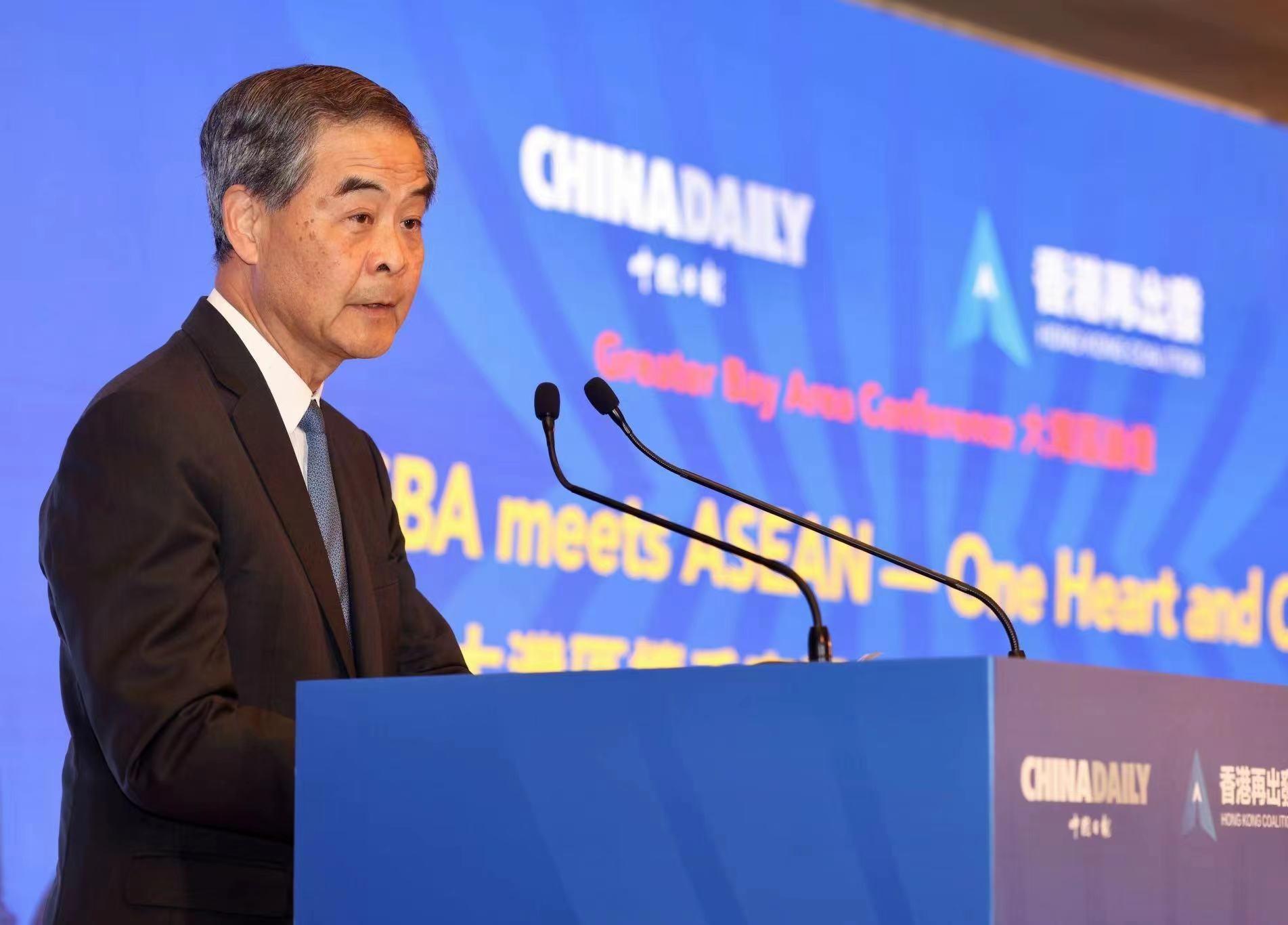 Vice-Chairperson of the National Committee of the Chinese People's Political Consultative Conference Leung Chun-ying delivers a keynote address at Greater Bay Area Conference 2023 in Hong Kong on Nov 22, 2023. (EDMOND TANG / CHINA DAILY )
Vice-Chairperson of the National Committee of the Chinese People's Political Consultative Conference Leung Chun-ying delivers a keynote address at Greater Bay Area Conference 2023 in Hong Kong on Nov 22, 2023. (EDMOND TANG / CHINA DAILY )
Good morning.
It is my great pleasure to attend the Greater Bay Area Conference 2023. I extend to the conference my warm congratulations.
The theme of this year’s GBA Conference is “When GBA meets ASEAN — One Heart and One Mind”. This to me is a perfect “superconnector” topic — Hong Kong superconnecting ASEAN and the GBA Guangdong cities.
Hong Kong is not just a platform, window or gateway which have physical or locational functions. As the superconnector, Hong Kong actively seeks out business opportunities and creates cooperative deals between the Chinese mainland hinterland and other countries — which gives Hong Kong one of the best neighborhoods in the world.
READ MORE: Conference captures GBA, ASEAN synergy
As today’s conference program shows, there is a wide range of superconnecting roles that Hong Kong can play between the GBA and ASEAN — green finance, green technology, art and culture preservation for tourism, etc. In this address of mine, I shall focus on Hong Kong’s role in trade.
Already, trade is the second-largest contributor to Hong Kong’s GDP, accounting for about 16 percent. The 105,000 trading companies now employ a total workforce of about 440,000 people. Yes, they are small, but efficient, responsive and versatile. Already, ASEAN is the biggest trading partner of China, and is the second-largest trading partner of Hong Kong, after the mainland. After earnest negotiations, in 2017 Hong Kong forged free trade agreements with all 10 member states of ASEAN, while China and ASEAN created in 2010 the ASEAN-China Free Trade Area. All these spell huge potential for Hong Kong as the superconnector in trade between China and ASEAN.
READ MORE: HK to 'connect, add value' to GBA-ASEAN collaboration
Trade is in Hong Kong’s DNA. There is an area in the Sheung Wan district of Hong Kong Island that is known as “Nan Bei Hang”, which literally means the “north-south trading hongs”. “Nan” is south and “Bei” is north. “Hang” is business entity. These enterprises specialized in cross-border trades which covered various parts of China, including the Guangdong cities of today’s GBA, and “Nanyang” — which included economies that formed the ASEAN of today. These trading hongs were located along the old shoreline of Hong Kong Island, before successive reclamations turned them into inland locations.
While the ownerships of the enterprises in Nan Bei Hang may have changed, the shops and trading companies in this part of Sheung Wan and Sai Ying Pun farther west still thrive. They demonstrate clearly how Hong Kong provides trade services for third parties. Incurring the wrath of environmentalists, Hong Kong is the world’s largest shark fin trade hub. Evidently, Hong Kong doesn’t produce shark fins and doesn’t consume this much shark fin.
The same applies to other dried seafoods. The website of the Home Affairs Department of the Hong Kong SAR government publicizes Sai Ying Pun as a trading hub for dried seafood. Interestingly, the medicinal herbs that are sold by the shops in Nan Bei Hang were produced in the mainland and most of the customers are mainland tourists. Then we have shops on Connaught Road Central that specialize in selling Chinese vegetable seeds in bulk to mainland farmers. Where are they produced? The Netherlands. We tell the Netherlands what mainland farmers need. Nearly all the merchandise that Hong Kong sells and buys are for third parties. Another example is the trade in Japanese foods. For more than a decade, Hong Kong is the biggest buyer of Japanese foods in the export market, similarly a very significant buyer of diamonds from India. We buy not just for Hong Kong’s own consumption, but also for other markets. We have been helping sellers access markets and helping markets source products.
READ MORE: HK to play pivotal, special role in green financing
The existence of these trades provides an insight into the competitive advantages of Hong Kong in the trade sector that have not changed in more than 100 years, and is unlikely to change in the foreseeable future — relationships, trust, open market, open-mindedness, level playing field, goodwill, language skills, currency stability and convertibility, and transport infrastructure. The only changes are that boats that relied on the trade winds have given way to container ships, and for Hong Kong, the cargo holds of flights — Hong Kong now has the busiest air cargo terminal in the world.
Distinguished guests, ladies and gentlemen, the trade sector of Hong Kong is predominantly made up of small and medium-sized companies, but these companies together are a very significant contributor to the economy of Hong Kong and others that they serve. It is important for buyers and sellers to appreciate the purposes they serve; namely, selling better than producers and buying better than customers. Both the suppliers and the markets in the GBA Guangdong cities and ASEAN countries will do well to recognize this super-connector role of Hong Kong.
I wish the Greater Bay Area Conference 2023 a complete success!


